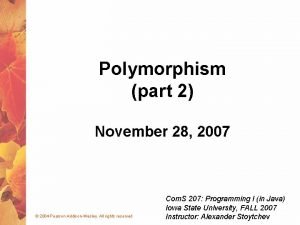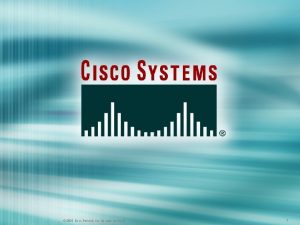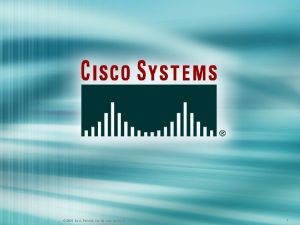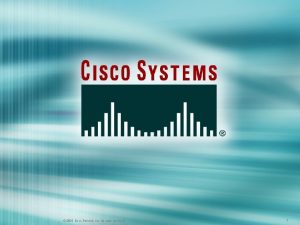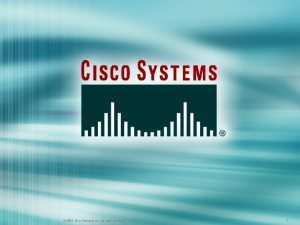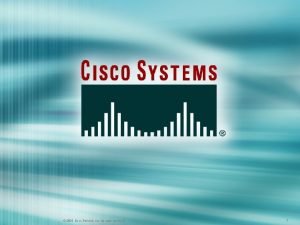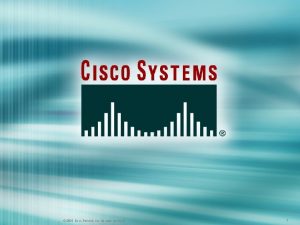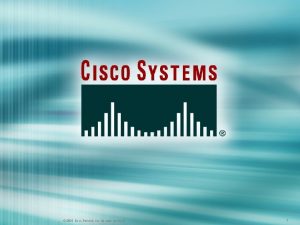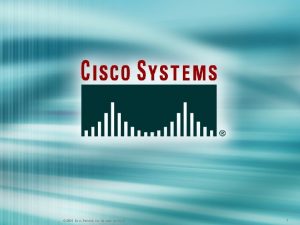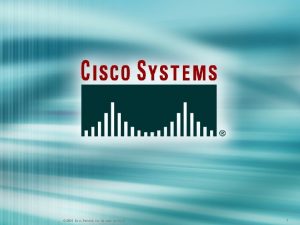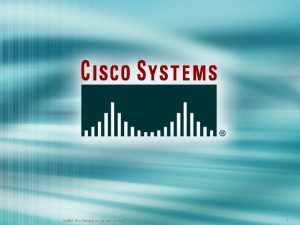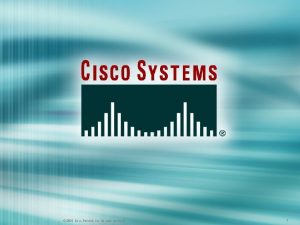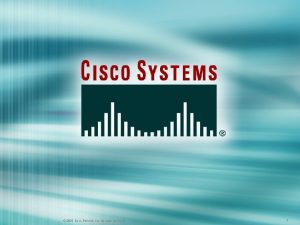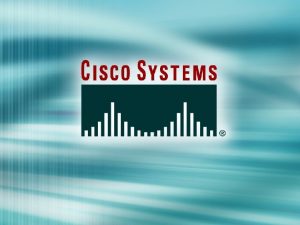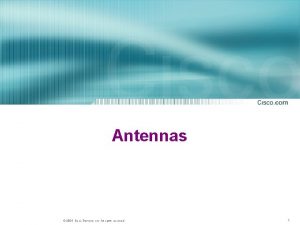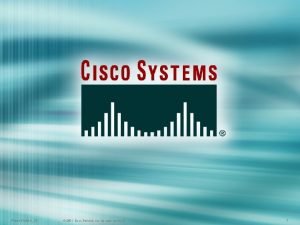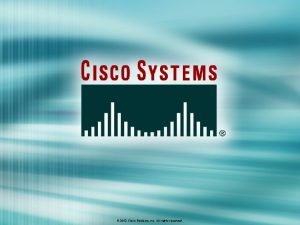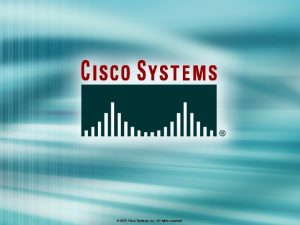Cisco Systems Inc All rights reserved 2004 2005

































- Slides: 33

© Cisco Systems, Inc. All rights reserved. © 2004, 2005 Cisco 1 1

Network Security 1 Module 10 – Configure Filtering on a Switch © 2005 Cisco Systems, Inc. All rights reserved. 2

Learning Objectives 10. 1 Introduction to Layer 2 Attacks 10. 2 MAC Address, ARP, and DHCP Vulnerabilities 10. 3 VLAN Vulnerabilities 10. 4 Spanning-Tree Protocol Vulnerabilities © 2005 Cisco Systems, Inc. All rights reserved. 3

Module 10 – Configure Filtering on a Switch 10. 1 Introduction to Layer 2 Attacks © 2005 Cisco Systems, Inc. All rights reserved. 4

Types of Attacks © 2005 Cisco Systems, Inc. All rights reserved. 5

Module 10 – Configure Filtering on a Switch 10. 2 MAC Address, ARP, and DHCP Vulnerabilities © 2005 Cisco Systems, Inc. All rights reserved. 6

CAM Table Overflow Attack © 2005 Cisco Systems, Inc. All rights reserved. 7

Mitigating the CAM Table Overflow Attack © 2005 Cisco Systems, Inc. All rights reserved. 8

Mitigating the CAM Table Overflow Attack © 2005 Cisco Systems, Inc. All rights reserved. 9

MAC Spoofing – Man in the Middle Attacks © 2005 Cisco Systems, Inc. All rights reserved. 10

Mitigating MAC Spoofing Attacks – Cisco IOS © 2005 Cisco Systems, Inc. All rights reserved. 11

ARP Spoofing © 2005 Cisco Systems, Inc. All rights reserved. 12

Mitigating ARP Spoofing with DHCP Snooping © 2005 Cisco Systems, Inc. All rights reserved. 13

Mitigating ARP Spoofing with DHCP Snooping © 2005 Cisco Systems, Inc. All rights reserved. 14

DHCP Starvation © 2005 Cisco Systems, Inc. All rights reserved. 15

Commands to Mitigate DHCP Starvation Attacks © 2005 Cisco Systems, Inc. All rights reserved. 16

Module 10 – Configure Filtering on a Switch 10. 3 VLAN Vulnerabilities © 2005 Cisco Systems, Inc. All rights reserved. 17

Switch Spoofing • Network attacker configures a system to spoof itself as a switch. • Requires Network attacker be capable of emulating either ISL or 802. 1 q along with Dynamic Trunk Protocol (DTP). • Can make a system appear to be a switch with a trunk port. © 2005 Cisco Systems, Inc. All rights reserved. 18

Double 802. 1 q Encapsulation VLAN Hopping Attack The first 802. 1 q header is removed VL AN 1, V LA N 2 Note: Only works if the trunk is configured with the native VLAN of the network attacker • • Send 802. 1 q double encapsulated frames Switch performs only one level of decapsulation Unidirectional traffic only Works even if trunk ports are set to off © 2005 Cisco Systems, Inc. All rights reserved. 19

Double 802. 1 q Encapsulation VLAN Hopping Attack The frame is forwarded with the second 802. 1 q header VLAN 1 Note: Only works if the trunk is configured with the native VLAN of the network attacker • • Send 802. 1 q double encapsulated frames Switch performs only one level of decapsulation Unidirectional traffic only Works even if trunk ports are set to off © 2005 Cisco Systems, Inc. All rights reserved. 20

Double 802. 1 q Encapsulation VLAN Hopping Attack The frame reaches a host on a VLAN that the attacker does not belong to VL A N Note: Only works if the trunk is configured with the native VLAN of the network attacker • • 1 Send 802. 1 q double encapsulated frames Switch performs only one level of decapsulation Unidirectional traffic only Works even if trunk ports are set to off © 2005 Cisco Systems, Inc. All rights reserved. 21

Security Best Practices for VLANs and Trunking - Mitigating VLAN hopping attacks • Always use a dedicated VLAN ID for all trunk ports • Disable unused ports and put them in an unused VLAN • Be paranoid – Do not use VLAN 1 for anything • Disable auto-trunking on user facing ports (DTP off) • Explicitly configure trunking on infrastructure ports • Use all tagged mode for the native VLAN on trunks © 2005 Cisco Systems, Inc. All rights reserved. 22

Private VLAN vulnerabilities • Private VLANs are a common mechanism to restrict communications between systems on the same logical IP subnet. • Limit the ports within a VLAN that can communicate with other ports in the same VLAN. • Isolated ports within a VLAN can communicate only with promiscuous ports. • Community ports can communicate only with other members of the same community and promiscuous ports. • One network attack capable of bypassing the network security of private VLANs involves the use of a proxy to bypass access restrictions to a private VLAN. © 2005 Cisco Systems, Inc. All rights reserved. 23

Private VLAN Proxy Attack NOTE: Private VLANs are not configurable on the Cisco Catalyst 2950 switch. © 2005 Cisco Systems, Inc. All rights reserved. 24

Defending private VLANs • ACLs can be configured on the router port to mitigate private VLAN attacks. VLAN ACLs (VACLs) can also be used to help mitigate the effects of private VLAN attacks © 2005 Cisco Systems, Inc. All rights reserved. 25

Module 10 – Configure Filtering on a Switch 10. 4 Spanning-Tree Vulnerabilities © 2005 Cisco Systems, Inc. All rights reserved. 26

Spanning Tree Attack Example • The attacker sends BPDU messages to become the root bridge Root Access Switches Requires that the attacker is connected to two different switches. © 2005 Cisco Systems, Inc. All rights reserved. BPD U Man in the middle and Do. S attacks become possible DU P B The attacker then sees frames he shouldn’t X Blocked 27

Spanning Tree Attack Example • The attacker sends BPDU messages to become the root bridge Access Switches Root Blocked X The attacker then sees frames he shouldn’t Man in the middle and Do. S attacks become possible This attack requires that the attacker is connected to two different switches. This can be done with either multiple NICs or a with a hub. Root © 2005 Cisco Systems, Inc. All rights reserved. 28

Preventing Spanning-Tree Protocol manipulation • Spanning-Tree Protocol Guard • Enable root guard or loop guard on all the VLANs associated with the selected interface. Root guard restricts which interface is allowed to be the Spanning -Tree root port or the path to the root for the switch. Loop guard prevents alternate or root ports from becoming designated ports when a failure creates a unidirectional link. © 2005 Cisco Systems, Inc. All rights reserved. 29

Preventing Spanning-Tree Protocol manipulation Spanning-Tree Protocol BPDU Guard Globally enable BPDU filtering on Port Fast-enabled ports –Prevents the switch port from sending or receiving BPDUs BPDU guard feature on Port Fast-enabled ports –Puts Port Fast-enabled ports that receive BPDUs in an error-disabled state Port Fast feature on all nontrunking ports. © 2005 Cisco Systems, Inc. All rights reserved. 30

Best Practices © 2005 Cisco Systems, Inc. All rights reserved. 31

Best Practices © 2005 Cisco Systems, Inc. All rights reserved. 32

© 2005, Cisco Systems, Inc. All rights reserved. 33
 Pearson education inc all rights reserved
Pearson education inc all rights reserved Pearson education inc. all rights reserved
Pearson education inc. all rights reserved 2010 pearson education inc
2010 pearson education inc Pearson education inc all rights reserved
Pearson education inc all rights reserved 2010 pearson education inc
2010 pearson education inc All rights reserved example
All rights reserved example Copyright 2015 all rights reserved
Copyright 2015 all rights reserved All rights reserved sentence
All rights reserved sentence Creative commons vs all rights reserved
Creative commons vs all rights reserved Confidential all rights reserved
Confidential all rights reserved Sentinel-controlled repetition
Sentinel-controlled repetition Copyright 2015 all rights reserved
Copyright 2015 all rights reserved Microsoft corporation. all rights reserved.
Microsoft corporation. all rights reserved. Microsoft corporation. all rights reserved
Microsoft corporation. all rights reserved Microsoft corporation. all rights reserved
Microsoft corporation. all rights reserved Dell all rights reserved copyright 2009
Dell all rights reserved copyright 2009 Warning all rights reserved
Warning all rights reserved All rights reserved c
All rights reserved c Quadratic equation cengage
Quadratic equation cengage Warning all rights reserved
Warning all rights reserved Confidential all rights reserved
Confidential all rights reserved Microsoft corporation. all rights reserved
Microsoft corporation. all rights reserved Copyright © 2018 all rights reserved
Copyright © 2018 all rights reserved Gssllc
Gssllc Confidential all rights reserved
Confidential all rights reserved Airbus deutschland gmbh
Airbus deutschland gmbh R rights reserved
R rights reserved Rights reserved
Rights reserved 2004 pearson education benjamin cummings
2004 pearson education benjamin cummings Child rights act 2005 images
Child rights act 2005 images Child rights act 2005 images
Child rights act 2005 images Child rights act 2005 images
Child rights act 2005 images Copyright 2005 pearson prentice hall inc
Copyright 2005 pearson prentice hall inc 2005 pearson prentice hall inc
2005 pearson prentice hall inc



























